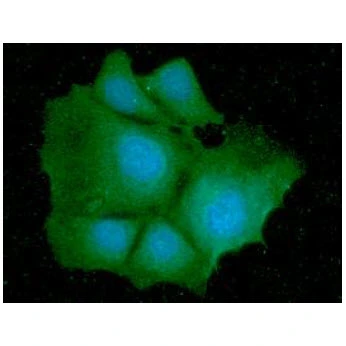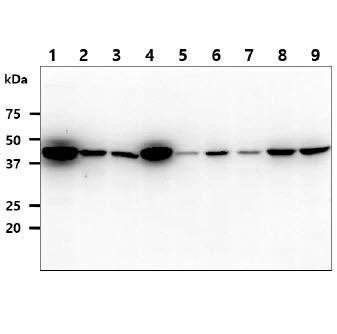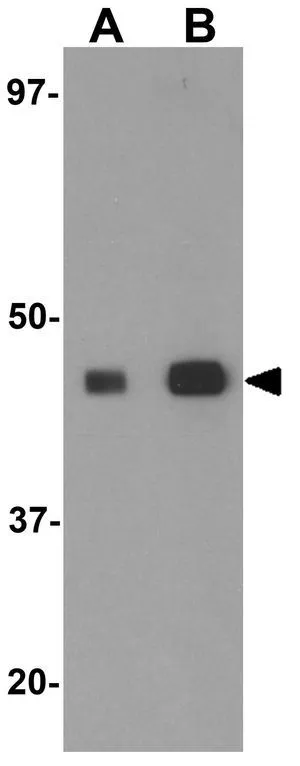
ICC/IF analysis of Hep3B cells using GTX57662 IDH1 antibody. Blue: DAPI Green: Primary antibody Dilution: 1:100
IDH1 antibody [AT25H10]
GTX57662
ApplicationsImmunoFluorescence, Western Blot, ImmunoCytoChemistry
Product group Antibodies
TargetIDH1
Overview
- SupplierGeneTex
- Product NameIDH1 antibody [AT25H10]
- Delivery Days Customer9
- ApplicationsImmunoFluorescence, Western Blot, ImmunoCytoChemistry
- CertificationResearch Use Only
- ClonalityMonoclonal
- Clone IDAT25H10
- Concentration1 mg/ml
- ConjugateUnconjugated
- Gene ID3417
- Target nameIDH1
- Target descriptionisocitrate dehydrogenase (NADP(+)) 1
- Target synonymsHEL-216, HEL-S-26, IDCD, IDH, IDP, IDPC, PICD, isocitrate dehydrogenase [NADP] cytoplasmic, NADP(+)-specific ICDH, NADP-dependent isocitrate dehydrogenase, cytosolic, NADP-dependent isocitrate dehydrogenase, peroxisomal, epididymis luminal protein 216, epididymis secretory protein Li 26, epididymis secretory sperm binding protein, isocitrate dehydrogenase (NADP(+)) 1, cytosolic, isocitrate dehydrogenase 1 (NADP+), soluble, oxalosuccinate decarboxylase
- HostMouse
- IsotypeIgG2a
- Protein IDO75874
- Protein NameIsocitrate dehydrogenase [NADP] cytoplasmic
- Scientific DescriptionIsocitrate dehydrogenases catalyze the oxidative decarboxylation of isocitrate to 2-oxoglutarate. These enzymes belong to two distinct subclasses, one of which utilizes NAD(+) as the electron acceptor and the other NADP(+). Five isocitrate dehydrogenases have been reported: three NAD(+)-dependent isocitrate dehydrogenases, which localize to the mitochondrial matrix, and two NADP(+)-dependent isocitrate dehydrogenases, one of which is mitochondrial and the other predominantly cytosolic. Each NADP(+)-dependent isozyme is a homodimer. The protein encoded by this gene is the NADP(+)-dependent isocitrate dehydrogenase found in the cytoplasm and peroxisomes. It contains the PTS-1 peroxisomal targeting signal sequence. The presence of this enzyme in peroxisomes suggests roles in the regeneration of NADPH for intraperoxisomal reductions, such as the conversion of 2, 4-dienoyl-CoAs to 3-enoyl-CoAs, as well as in peroxisomal reactions that consume 2-oxoglutarate, namely the alpha-hydroxylation of phytanic acid. The cytoplasmic enzyme serves a significant role in cytoplasmic NADPH production. Alternatively spliced transcript variants encoding the same protein have been found for this gene. [provided by RefSeq, Sep 2013]
- Storage Instruction-20°C or -80°C,2°C to 8°C
- UNSPSC12352203





![IHC-P analysis of human astrocytoma tissue using GTX57185 IDH1 (R132H Mutant Specific) antibody [IHC132]](https://www.genetex.com/upload/website/prouct_img/normal/GTX57185/GTX57185_20180619_IHC-P_w_23061123_436.webp)
![ICC/IF analysis of COS7 cells transiently transfected with IDH1 plasmid using GTX84319 IDH1 antibody [2H9].](https://www.genetex.com/upload/website/prouct_img/normal/GTX84319/GTX84319_1029_ICCIF_w_23061420_215.webp)
![IHC-P analysis of human prostate carcinoma tissue using GTX34793 IDH1 antibody [IDH1/1152].](https://www.genetex.com/upload/website/prouct_img/normal/GTX34793/GTX34793_20200115_IHC-P_1036_w_23060801_658.webp)
